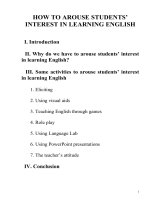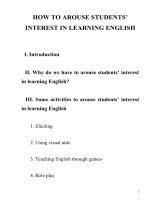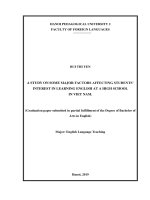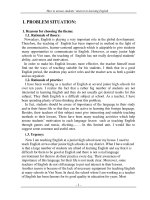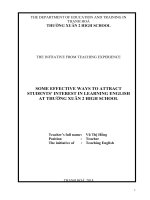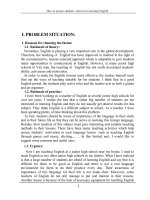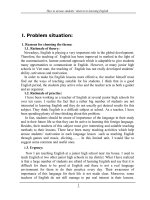SKKN HOW TO AROUSE STUDENTS’ INTEREST IN LEARNING ENGLISH
Bạn đang xem bản rút gọn của tài liệu. Xem và tải ngay bản đầy đủ của tài liệu tại đây (317.89 KB, 16 trang )
HOW TO AROUSE STUDENTS’
INTEREST IN LEARNING ENGLISH
I. Introduction
II. Why do we have to arouse students’ interest
in learning English?
III. Some activities to arouse students’ interest
in learning English
1. Eliciting
2. Using visual aids
3. Teaching English through games
4. Role play
5. Using Language Lab
6. Using PowerPoint presentations
7. The teacher’s attitude
IV. Conclusion
1
HOW TO AROUSE STUDENTS’ INTEREST
IN LEARNING ENGLISH
I. Introduction
“My students are very lazy and stubborn. When I explain the lessons, they
don’t pay attention and let their mind wander. When I ask them to do the
homework, they just ask other people for help. When I ask them to learn the
lessons, they ignore it or just spend little time doing that. I don’t know what to do
now.”, a teacher of English complained. This is a common case in many classes of
English. What’s the solution to that problem? We cannot use the rod to force our
students to learn. Nor can we split their heads to put the knowledge into them.
What can we do? The better way is to arouse students’ interest in learning English.
Once students have interest in learning English, they themselves will try their best
to learn it.
II. Why do we have to arouse students’ interest in learning
English?
Many teachers wrongly see students as machines to be programmed (“ I’ve
taught them the present tense. They must know it”). But students are people.
People think but they also have feelings. Students may be learning about machines,
but they still learn as human beings. Learning, particularly the learning of a
language, is an emotional experience. The feelings that the learning process evokes
will determine the success of the learning. Whatever technical virtues a teacher
possesses, however good at the language the teacher is, without interest the
students will never learn.
If the students are bored, they will not pay attention. And the result is that
they won’t learn. Moreover, if they are not interested in learning, they will be
easily distracted. Then they will get up to mischief and prevent others from
learning. That’s why we have to arouse students’ interest in learning English.
The teacher must provide interest through:
-identifying and catering to the students’ interests in terms of topics, e.g.
themselves (the most interesting topic of all), their hobbies, ambition,
dreams;
- variety of language points., skills practiced, interaction TS, ST, SS,
pair/ group activities;
-humour (in visual aids e.g. cartoons, anecdotes and jokes as reading or
listening passages, mime);
-inherently interesting tasks, e.g. problem solving.
Remember that students are more likely to be interested in you and what you
are doing if you show an interest in them. No matter how big your class, you must
try and get to know your students as people and not just as numbers in a register.
Do not regard time in class spent on learning about your students as wasted time.
On the contrary, the extra motivation generated through this will more than
compensate.
2
III. Some activities to arouse students’ interest in learning
English
There are various activities in a classroom to arouse students’ interest in
learning English. In this limited unit, I would like to suggest some common and
useful ones.
1. Eliciting
In many classes, it is the teacher that talks while the students listen. If
the students speak at all, it is usually to repeat what the teacher says, or to
answer a set question. This way of teaching will obviously make the
students feel bored and frustrated. Instead of simply giving words,
sentences, or structures, the teacher should involve the students more by
drawing them from the students. He should ask them for their ideas and
suggestions, getting them to contribute what they know already, and
encouraging them to guess new words. This is called eliciting.
Eliciting involves the class by focusing student’s attention and making
them think. This happens even if students do not know the words being
elicited; so elicitation can be used for presenting new language as well as
reviewing what was taught earlier. Furthermore, eliciting encourages
students to draw on what they already know or partly know. So it is a useful
technique for mixed ability classes or classes of students from different
learning backgrounds, where different students know different things. In
addition, eliciting gives teachers a chance to see what students know and
what they do not know, and so adapt the presentation to the level of the
class. Of course, eliciting takes more time than straightforward presentation
of new language. However, it will catch students’ attention and they will
remember the lesson more.
Some ways of eliciting:
a. Eliciting from pictures
Using pictures to elicit is the easiest way to introduce a new topic
or new vocabulary. When eliciting from pictures, it is often best to ask
fairly general questions that allow a variety of responses. This
encourages more students to respond and leads them to say more. For
example, to elicit from the picture in unit 1 of the textbook “TIẾNG
ANH 10” (on page 12), the teacher can ask, “What is the man’s job?
Why do you know that?”. Students could answer “He is a farmer
because he is in the field/ he is with a buffalo/ he is ploughing/ he is
harrowing, etc.”
Sometimes the students cannot answer the questions because they
don’t know the vocabulary. In this case the teacher should present it.
The advantage of trying to elicit it first is that students’ attention will
now be focused on the word and they should be listening with greater
interest.
b. Getting students to guess
Because language follows rules, it is often possible to guess things
which we have never actually been taught, and an important part of
3
learning a language is developing this ability to make guesses. Eliciting is
one way of encouraging students to guess and to work out rules for
themselves. Learning through this way will fill students with enthusiasm.
EX: I don’t mind waiting.
Would you mind closing the window?
She doesn’t mind ____?____(do) the housework.
The students will know the answer is “doing:”
When getting students to guess, the teacher should pay attention to
these points:
- The teacher should pause after asking each question, to give students time
to think
- The teacher should vary his or her questioning technique according to the
difficulty of the question, letting good students answer difficult questions
and directing easier questions at weaker students. In this way the whole
class will be involved.
- The teacher should try to elicit “onto the blackboard’, building up a set of
examples as students respond
c. Getting students to imagine
A textbook often include only questions that would be to elicit key
vocabulary or structures, or to establish a situation or topic. Therefore, the
teacher should take every opportunity to ask questions that require students
to interpret what is in a picture or a text ((EX: To get students to interpret the
picture in unit 1 of the textbook “TIẾNG ANH 10” (on page 12) the teacher
can ask “Why is the man in the field?”), or to imagine things beyond a
picture or a text (EX: What will happen next?). There are no single “right”
answers to these questions but a wide range of possible answers. Students
are encouraged to express their own ideas and feelings. Questions of this
kind encourage students to give a more imaginative, personal response. If
we ask questions like that, we can involve the class in discussion and can
stimulate freer use of language.
2. Using visual aids
There are various kinds of visual aids that we can use to teach English such
as the blackboard, real objects, flashcards, charts, the teachers ourselves, flannel
board, slides, coloured rods, etc.
Using visual aids has a lot of advantages:
- Showing visuals focuses attention on meaning, and helps to make the
language used in the class more real and alive.
-Having something to look at keeps the students’ attention, and makes the
class more interesting.
-Visuals can be used at any stage of the lesson- to help in presenting new
language or introducing a topic, as part of language practice, and when
reviewing language that has been presented earlier. Good visual aids are
not just used once, but again and again, and can be shared by different
teachers.
In this part, I would like to study some familiar visual aids used in a classroom.
4
a. The blackboard: The teacher or students can use it to draw pictures,
diagrams, maps, etc. simple pictures drawn on the blackboard can help to
increase the interest of a lesson, and are often a good way of showing
meaning and conveying situations to the class. Blackboard drawings should
be as simple as possible, showing only the most important details. It is not
necessary to be a good artist to draw successfully on the blackboard- a lot of
information can be conveyed by means of very simple line drawings and
“stick figures”, which are easy to draw. It is important to draw quickly so as
to keep the interest of the class. Teachers should also talk as they draw: in
this way the class will be more involves, and will understand the picture on
the board both from seeing it and from listening to the teacher.
b. Real objects: (sometimes called “realia”): They can be the things that are
already in the classroom such as fan, desk, table, wall, clothes, etc. We can
also bring them into the classroom.-food, clothes, household objects,
containers, etc. Real objects are in many ways the easiest kind of visual aid
to use in class, as they need no special preparation or materials. Simple
objects can be used not only for teaching vocabulary but also as prompts to
practice structures and develop situations.
EX: The teacher can show a cell phone
-to teach the word “cell phone”
-to practice the structure “What …for?”( What is a cell phone used for?- It is
used to talk to people when you are away from home.)
-to develop an imaginative dialogue:
Student 1: Could you lend me your cell phone?
Student 2: Yes, of course. What do you want it for?
Student 2: My sister has been to Hanoi. I’d like to phone her.
c. Charts: They are large sheets of card or paper with writing, pictures or
diagrams, used for more extended presentation or practice. They would
usually be displayed on the wall or blackboard, or the teacher can hold up
for the class to see.
EX: To teach the word “erosion”, the teacher can show this picture
5
Using charts is convenient because of the following reasons
-The teacher does not have to spend time in the lesson drawing or writing on
the blackboard
-As the chart is prepared in advance, it is possible to draw the pictures or
tables more carefully, and also to make them more attractive (e.g. by using
colour)
-The chart can be kept and used again with the same class (e.g. for review,
or to practice a different tense), or used with other classes and by other
teachers.
-The textbooks we are using now are up-to-date and have good illustrations.
There may be no need for teachers to make charts. However, it may still be
worthwhile to copy some visual material from the books onto charts, so
that the teacher can introduce the lesson in a more interesting way, or
review earlier lessons, or simply to make a change of activity.
d. Flashcards: They are cards with single pictures which can be held up by the
teacher. They can be used for presenting and practising new words and
structures, and for revision. The teacher can draw a picture on the flashcard,
or stick on a picture from a magazine; flashcards can also be used to show
words or numbers. We can make good flashcards by paying attention to
these points:
-They should be large enough – at least 20 x 14 cm. (half a piece of typing
paper)
-Pictures can be drawn, using a thick pen so that they are clear, or they can
be cut from a magazine; pictures from magazines are often more interesting
to look at, but it is difficult to find pictures which are the right size and
which are simple enough.
-If possible, flashcards should be made on pieces of white card – then they
can be kept and used again.
e. The teachers ourselves: The teacher can use gestures, facial expressions, and
actions to help show the meaning of words and to illustrate situations. The
teacher can swing their arms to teach the word “swing”. He can mime
someone sneezing to teach the word “sneeze”. Most action verbs (sit, stand,
write, etc) and some adjectives (happy, worried, etc) could be taught in this
way.
3. Teaching English through games
Students are greatly keen on participating in games. So teaching English
through games is the most effective way to make students learn. From my
personal experience and from some reference books, I would like to introduce
some common games.
a. Guessing game
+ Students write a word or a sentence on a piece of paper
+ The teacher has a student go to the front of the class. Other students ask yesno questions to guess the word or the sentence.
+ The student who can guess the word or the sentence will replace the other
student and continue the game.
6
+ The teacher can also divide students in groups. Each group will think of a
word or a sentence and the representative of each group will go to the front of
the class in turn. The group who can guess the word or the sentence will get
three marks. The group with more marks will be the winner.
b. Lucky numbers
+ Have students form groups (It is up to the number of the students in class)
+ Write on board some numbers
EX: 1
2
3
4
5
6
7
8
9
10
+ There are some lucky numbers (e.g. 2, 5, 9). The group who choose the lucky
number will get 2 marks without doing anything.
+ The other numbers will show a question or an order. If the group can answer
the question or perform the order well, that group will get 2 marks. If that group
cannot answer the question or cannot perform the order, the other groups will
have the right to do them.
+ When all the numbers have been chosen, the group with more marks will be
the winner.
c. Jumbled letters
EX: Rearrange these letters to make a meaningful word: sweta
?
(Key: waste)
d. Word square
+ The teacher shows a word square on the board and form 2 or 4 groups of
students. The teacher gives the topic related to the words and the number of
words that need to find. The representative of each group will go to the board
and circle the words. The group with more correct words will be the winner.
EX:
Find the new words in the reading text of unit 4 (English 11)
P
T
Y
M
O
Q
L
L
E
B
O
T
R
C
A
J
R
W
E
R
O
W
M
A
M
V
K
Z
N
C
O
U
F
N
L
K
T
N
T
S
D
X
E
S
U
F
F
E
R
Key:
7
P
T
Y
M
O
Q
L
L
E
B
O
T
R
C
A
J
R
W
E
R
O
W
M
A
M
V
K
Z
N
C
O
U
F
N
L
K
T
N
T
S
D
X
E
S
U
F
F
E
R
make
a bed
a cake
a decision
an error
a mess
…
…
…
e. Word forks
+ The teacher writes on the board the word forks.
EX:
+ Have students work individually or in groups to find the information to fill in the
word forks
?
?
rock
+ The?first student
abroad or the first
?
group that can
? complete the task correctly will be the
?
cartoon
winner.
listening to music
f.? Word nets ?
documentary
+ Thetravelling
teacher writes on the board the word nets.
watching
EX:
television
HOBBIES
reading books
?
?
?
comic
swimming
?
in the river
8
?
?
?
?
?
?
?
+ Have students work individually or in groups to find the information to fill in
the word nets.
+ The first student or the first group that can complete the task correctly will be
the winner.
g. What and where
+ Draw circles on the board corresponding to the number of the words that have
just been taught.
+ Write the words onto the circles.
+ Have students read the words.
+ Rub out the words in turn and have students read aloud the word that has just
been rubbed out
+ Have students write the words again onto the correct circles.
h. Kim’s game
+ Divide the class into groups.
+ Show students some objects or pictures
+ Hide the objects or pictures.
+ Call on the representative of each group to go to the board to write the names
of the objects or pictures. The groups with more correct names will be the
winner.
i. Slap the board
+ Write new words or stick pictures onto the board.
+ Call on two groups to go to the board (Each group has four or five students)
+ Have each group stand in the same distance.
+ Say aloud the words in Vietnamese if the words on the board are in English
and vice versa. (Say the words in English if using the pictures)
+ The students of the two groups will go to the board and slap the word said
aloud.
+ Give marks to the group that can slap the word more correctly and quickly.
+ The groups with more marks will be the winner.
j. Find someone who
+ Write the table on the board. Have students write it on their notebooks
Use a computer
Speak French
Cook
Play the guitar
Name
Nam
9
swim
+ Have students make yes-no questions for the words in the left (e.g. Can you
use a computer?)
+ Give model with a student. Ask a question (e.g. Can you use a computer?). If
the student answer “Yes”, write his name on the column “Name”.
+ Have students go around the class and ask other students to find the names to
fill in the table. The names must be different. The student who can fill all the
blanks first is the winner.
k. Simon says
+Say aloud orders. Students just perform the teacher’s orders if the teacher
begins with, “Simon says”
+If the teacher says, “Simon says: stand up”, the students will stand up
+ If the teacher says, “stand up”, the students will not stand up
+ The students who make mistakes will be punished in some funny way.
l. Pelmanism
+ Prepare some cards. Write the content that need to be practised on one side
of each card. (e.g. the content is to practise the verbs of the present and past
tense. Write 10 verbs of the present tense on ten cards and stick them on the left
of the board. Write the past tense of the verbs on other ten cards and stick them
on the right of the board. The side of each card which is blank must be shown.)
+ Divide the class into 2 groups. Have each group choose 2 cards in turn.
+ Turn up the chosen cards. If they belong to the same verb (e.g. eat – ate), that
group will get marks. If not, turn down the cards and stick them on the same
position. Continue the game until all the cards are turned up.
+ The groups with more marks will be the winner.
m. Noughts and crosses
+ Draw a table of nine squares. Each square contains a word or a picture.
EX:
Souvenir
Supermarket shop
school
Post office
Bookstore
Village
Hotel
street
School
+ Divide the class into 2 groups: one is “Noughts” (O) and the other is
“Crosses” (X)
+ Have the groups choose the words in the squares and make sentence with that
word (e.g. There is a post office near my house)
+ The group with the correct sentence will receive a “O” or a “ X”
+ The group with three “O” or “ X” in the same vertical line, diagonal line or
horizontal line will be the winner.
10
n. Crossword puzzles
Find the word which means:
1. say one is sorry, esp for having done sth wrong
2. give money so that sth will happen
3. finish
4. happening or done once every year
5. encourage or make sth more active
6. give sth to sb as a prize
7. without problems or difficulties
8. enthusiasm an energy
9. make sth known publicly
10.competition
What is the word in the grey column?
1
2
3
4
5
6
7
8
Key:
9
10
11
3
4
5 S T
7 S
9
10
2
C
A
I
6
M
8
A
1
S
O
N
M
A
O
S
N
C
A
P
M
N
U
W
O
P
N
O
P
O
P
U
L
A
T
I
O
N
O
N
L
A
A
R
H
R
U
T
L
S
E
L
T
D
L
I
N
E
O G I S E
O R
T E
E
Y
T
C E
S T
o. Word dominoes
EX: …cheatomatonakedirector…
p. “Composing Stories”
This game can be played by the whole class or in groups. The purpose of
this game is to cultivate students’ reading comprehension and memory. For
example, delivering ten disordered sentences of a paragraph from a text which
students have learned. The winner will be the group who can rearange it
correctly and fastest.
k. Miming
+ Divide the class into groups.
+ The representatives of the groups will go to the front of the class to mime a
job or an action in turn.
+ Each correct answer will be given 1 mark. The group that has the student
miming and can give the correct answer will be given 2 marks. The group with
more marks will be the winner.
r. The teacher can also design games which are similar to popular games on
television such as “Chung sức”, “Rung chuông vàng”, “Đường lên đỉnh
Olympia”, etc. (Instead of using Vietnamese in these games, we will use
English)
EX: The game which is similar to the game “Chung sức”:
+ Divide the class into 2 groups.
12
+ Say: “I had a survey on 100 students and got 10 answers to this question. If
you give one of those answers, you will receive the marks which are equivalent
to the numbers of the students giving that answer.”
+ The teacher writes on the board:
1. ____________ (20 students)
2. ____________ (17 students)
3. _____________(15 students)
4. ____________ (12 students)
5. _____________(11 students)
6. _____________(9 students)
7. _____________(7 students)
8. _____________(5 students)
9. _____________(3 students)
10. ____________(1 student)
+ Have the representatives of the groups go to the front to slap the board to get
the right to answer.
+ Ask the question: “What do you often do in your free time?”
+ The student who slaps the board first will get the right to answer first. Then
each group will give one answer in turn.
Answers:
1. watching television (20 marks)
2. listening to music(17 marks)
3. chatting on the phone(15 marks)
4. playing computer games(12 marks)
5. going shopping(11 marks)
6. reading books(9 marks)
7. playing sports(7 marks)
8. meeting friends(5 marks)
9. traveling(3 marks)
10. sleeping(1 mark)
+ After all of the ten answers are given, the group with more marks will be the
winner.
4. Role play
Role play is a way of bringing situations from real life into the class room.
When we do role play, we ask students to imagine. They may imagine:
- a role: in other words, they pretend to be a different person (e.g. a farmer);
- a situation: in other words, they pretend to be doing something different (e.g.
planning a holiday)
- both a role and a situation (e.g. a police officer asking about a lost bag).
In role play, students improvise. The situation is fixed, but they make up the
exact words to say as they go along. ( So reading a dialogue aloud is not the same
as role play.)
Role play increases motivation. Always talking about real life can become
dull, and the chance to imagine difference situations adds interest to the lesson.
Children and even teenagers and adults often imgine themselves in different
13
situations and roles when they play games. So by using role play in class, we are
building on something that students naturally enjoy.
When using role play, bear in mind that the situations we use for role play
should as far as possible within the experience of the students. In general, the more
familiar a role or situation is, the easier it will be.
Suitable roles for school classes would be:
- People familiar to students from everyday life, e.g. parents, brothers, sisters,
teachers, shopkeepers, police officers.
- Characters from the textbook, and from other books or from television.
Suitable situations:
- Situations which students see or take part in in everyday life, e.g. shopping,
holidays, using local transport, asking the way to places.
- “Fantasy” situations from stories they read, or rom the textbook.
5. Using Language Lab
To inspire students with great interest, we can teach them in a language lab
In fact, there are many benefits of using the lab to teach English, especially in
teaching speaking and listening. In a language lab, the teacher can easily show a
picture, a film, or play a song without taking a lot of time. Besides, the noise from
films, songs or students’ activities will not cause any trouble for any surrounding
classes. In addition, students can enjoy eye-catching pictures with wonderful
soundtracks which make them feel eager and give them interest in learning the new
lesson.
EX:
To lead in unit 10 (Conservation), “TIẾNG ANH 10”, the teacher shows
students a video clip of a forest fire and asks:
- What is happening ?
- Is it good or bad for our environment? Why?
- What should we do to prevent it ?
After seeing the video clip, the students will be more interested in answering
the questions and they will remember the lesson better.
6. Using PowerPoint presentations
PowerPoint presentation can make the class teaching interesting. It can help
catch the students' attention with the help of some vivid and propar pictures or
14
sounds. The interesting sounds and flashes can cheer students up in class. Thus
students may be more impressed and remember the vocabulary or sentence
patterns easily and can keep the memory longer.
PowerPoint presentation is a great way of displaying pictures and linking to
movie clips. It does break the monotony in the classroom and adds variety. You
have access to many teaching tools when you can produce your lesson plan with
PowerPoint. Pictures of vocabulary words, hyper links to informational You Tube
videos, and recorded dialogues are just a few of the many features you can
incorporate into your PowerPoint lesson plan to make it engaging and informative
to your students.
Pictures:
You could use photographs and clip art to help you explain the meaning of
the words you are trying to teach. Students will have a better understanding of new
words if they can see pictures to help them understand the meanings. Keep your
pictures relevant and simple, however. There is no need to fill a slide up with
photographs to help explain just a few words.
Recorded Audio:
You can record the pronunciation of new words, custom dialogues, English
songs or listening exercises for your students to play at appropriate times during
your lesson with a PowerPoint-presented lesson. Students will be able to hear
authentic speech during the lesson. You can send your lesson to your students after
class so that they can then review the speech that they heard during the lesson on
their own time and repeat it as many times as they think necessary to better
understand it.
Video:
Put a link to a You Tube video into your lesson if you want to show a video.
For example, if your lesson is about job interviews, you can show a short video on
how to act during a job interview. Students can then discuss pre-determined
questions you have given, listen for new vocabulary you have pre-taught, or
perform their own job interviews after watching the video.
Games:
I sometimes used games on PowerPoint and found that students were very
interested. They love games all the time, especially those they had seen on TV.
Teachers can use PowerPoint to create their own games to use in the
classroom or they can download them. There are many excited PowerPoint games
on the Internet. For example, you can download from this web: There are so many useful games there. After
downloading, you can change the contents so that they are suitable for your lesson
purpose.
Using PowerPoint is a good way of teaching. However, there may be some
dangers in using it. Therefore, teachers should be very careful when making a
PowerPoint presentation. PowerPoint can help a lot in language teaching and
learning as long as the teacher use it proparly.
7. The teacher’s attitude
To make students learn, the teacher must seek to encourage the students.
This encouragement involves all aspects of the teacher’s role – a sympathetic
15
attitude, not demanding beyond the students’ capabilities, not overcorrecting,
praising what has been well done.
Some teachers always force students to learn and get angry if they don’t.
What’s the use of forcing students to do what they do not like or cannot do?
That just gives students fear, stress and dislike in learning. We should try to create
a lively and pleasant classroom atmosphere with a smiling face, sense of humour, a
sympathetic attitude, and interesting tasks so that students feel that they love to
learn. But we should not be so easygoing. Sometimes we should be strict to
manage our students better.
Some teachers say that their students always make mistakes and they have to
correct them all the time. Neither teacher nor students should worry too much
about small mistakes. The important thing is that students should understand and
be understood. If a student asks the question “You want collect our books?” he
should be corrected but first and more important, he should also be praised –
‘Good, Well done. Yes, I want to collect our books. You ask the question again so
everyone can hear it – Listen. “Do you want to collect our book?” Now you ask.
Good’. In this way the form of the question has been corrected but the student has
been given full credit for making himself understood. This method increases
student motivation, he will now be keen to try again and not nervous of making
mistakes.
The teacher should also give praise to the students even if they make very
small progress. Use the encouraging words , such as Good , OK, CLEVER and
use “try” , “Do your best “, or “ I believe you can do better next time.” which can
encourage students and help them build self-confidence instead of “No” , “ You
can’t “ . Then the students can learn English harder and harder and get better
achievement. Day by day the interest in learning English is brought up, and the
students want to learn English self-consciously.
IV. Conclusion
Learning is a personal journey. We are simply a guide. Our students have to
do the traveling. A guide can’t force a tourist to see what he or she doesn’t want to
see. We organize a learning environment, but we can’t learn for the students. They
have to do the learning themselves. So the teacher should teach the essential things
and things that motivate the students. Besides, English lessons are like the
medicines that the students should take. They may still need to be sweetened with
the sugar of enjoyment, fun, creativity and a sense of achievement. That is the
reason why the teacher should create activities that can arouse students’ interest in
learning English. It may take time and energy to do so or you can get failure in the
first few times. Don’t worry. It is said that “Cultivation of the soil serves ten years’
interest. Cultivation of the mind serves one hundred years’ interest”. And
remember the English proverb: “If at first you don’t succeed, try, try again”.
16
REFERENCE BOOKS
Teach English, a training course for teachers, Adrian Doff, Cambridge
University Press in association with The British Council. (1988 )
Teaching English through English, a course in classroom language and
techniques, Jane Willis, Longman
Thiết kế bài giảng TIẾNG ANH 10, TIẾNG ANH 11, TIẾNG ANH 12, Chu
Quang Bình, nhà xuất bản Hà Nội
Material from Phạm Tấn, Ho Chi Minh University of Education Department of
English.(2006)
ELT Methodolody from Nguyễn Thành Yến, Ho Chi Minh University of
Education Department of English.(2000)
Tài liệu bồi dưỡng giáo viên thực hiện chương trình sách giáo khoa lớp 10, lớp
11, lớp 12 trung học phổ thông môn TIẾNG ANH ,nhà xuất bản Giáo dục
Teaching English as a second language, Harold B. Allen, university of
Minnesota
17
